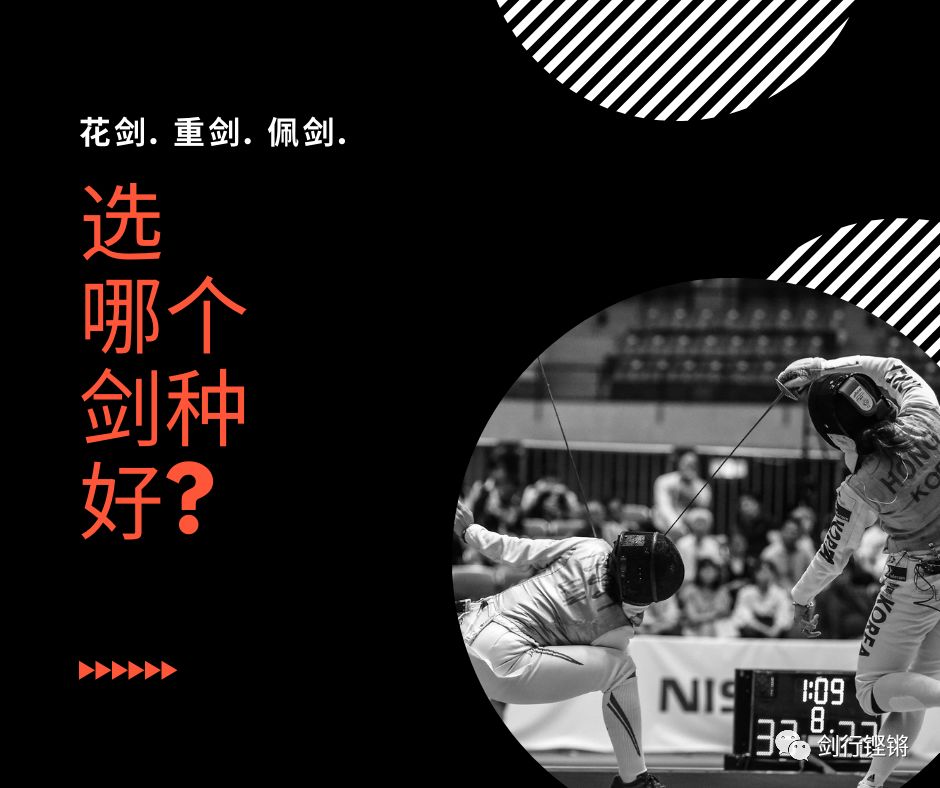For English version please scroll down to the end.

新手剑爸剑妈上路,要了解的东西很多,其中一个重要决定就是:我的孩子到底应该学习哪个剑种呢?
在回答这个问题之前,先声明一点:三剑种——花剑、重剑和剑种之中没有好坏之分。剑种的选择也没有标准答案,澳洲国家队教练、击剑大师Antonio Signorello也对此表示赞同。
在写下这些文字的时候,我身边正好坐着几位击剑家长,随机问了一下她们孩子的剑种是怎么定下来的。一位是孩子自己想学,母亲找到新州击剑中心,试课后教练看了一下,建议花剑起步,一个月后父母和教练进行了深入讨论,在听取孩子反馈后定下来花剑;另一位是学校有课外活动,只有一个剑种,就没多想开始了,后来孩子也有机会尝试了其他剑种,也是进一步坚定了当初的选择;另一位是孩子参加了假期的训练营,有机会玩了三个剑种,很快就定了自己喜欢的剑种。
我们作为击剑父母,其实在寻找最适合孩子、孩子自己也最喜欢的剑种,通常找对了剑种,孩子的潜能也得到了最大可能的发挥。
第一件事可以尝试的是,上网观看一下三个剑种的比赛视频,观察一下孩子的直接反应和评论。他/她看到哪个剑种更兴奋?认为哪个剑种更酷?哪个剑种他/她看得更仔细,注意到一些细节?
即使你对击剑所知不多,直观地观看视频,你也会留意到:

花剑的集中有效部位比重剑和佩剑都要小,快速的步伐移动,攻守转换的背后需要快速思维、敏捷的身体和耐力的支撑。不同国家的花剑选手身高不一,从一米七左右到两米高的都有。

反观重剑选手,普遍都是高个大长腿,身高的优势在重剑上不容小觑。重剑的全身都是有效击中部位,大家会看到重剑选手出手都非常谨慎,比赛节奏是三剑种里最慢的。是不是会受那些特别喜欢动脑筋思考的剑手的青睐呢?

而佩剑无疑是节奏最快、最令人兴奋的剑种。每次现场看佩剑比赛,绝对是热血沸腾的感觉。佩剑剑条的快速劈砍动作对于爆发力超群的剑手有着“致命”的吸引力。
如果你的孩子比较小,一时间没有明显倾向性,你自己也没有太多击剑知识,一个保险的起步剑种是花剑。然后鼓励她/他慢慢尝试其他剑种,看看有没有偏向性。如果有,恭喜你,谜题不攻自破!兴趣是最好的老师,你已经有了一个平稳的起步。
现实的情况是,从花剑起步,无论是改重剑,还是佩剑都有可能。几乎没听说过起步重剑,后面改玩佩剑的,或者反之。

如果你的孩子尝试了上述方法后,仍然不知道。这时候,是需要父母介入的时候了。“介入”不是代替孩子做决定,更多的是通过与教练、孩子不同角度的沟通,来寻找问题的答案。这个沟通的过程是对一些因素对考量,比如:
孩子的身体条件
比如孩子的预测身高、臂长。身高明显高于同龄人的孩子可以郑 重考虑一下重剑。孩子的爆发力、耐力、敏捷度和协调能力。爆发力明显突出的孩子可以从佩剑入手。
孩子的思维和反应速度,性格
一般说来,敢冲敢打、反应快的孩子是玩佩剑的好料子;相反性格的可能就是玩重剑的好料子。花剑作为攻守平衡的剑种,对于综合能力的要求要高一些。
教练的专长
击剑在澳洲是高端小众项目,在地广人稀的国度击剑俱乐部是星星之火般的存在。离家近的俱乐部可能只提供一个剑种,但可惜不是你的孩子想玩的。这时候作为父母还是要衡量,到底是辛苦一点开远一点跟一个合适的剑种教练还是就近跟着一个不是首选剑种的教练?
此外,击剑这个运动的特别之处是需要跟着教练持续性地一对一上小课。教练的重要性不言而喻。
对练对手的数量和质量
作为一个对抗性体育项目,对练的质量和数量也是需要考虑的。对打过程中,孩子在运用、巩固私教课所学,在试错中成长。看美国的情况,确实有一些天才剑手在很小的俱乐部也取得了成功,但不可否认,一个水平层级丰富、高手云集的俱乐部对于孩子的提高是非常有帮助的。如果对练伙伴只有一两个,打到最后,因为太熟悉的缘故,有时会进入“自动导航”状态。而不同风格、更多的对练伙伴,会激发孩子在剑道上更多的思考。

当孩子开始规律性参加比赛后,特别是玩花剑和佩剑的孩子,经常会对裁判关于主动权的判罚多有怨辞。我也曾经遇到过一个剑手告诉我他花剑改重剑,因为受不了业余裁判判花剑的时候出错。坦率地说,即使是世界级击剑赛事,有时不同裁判关于一些模棱两可的剑的判罚都会有不同观点,这算是击剑的特别之处吧。总之,当剑手学会与裁判沟通后,他/她对赛场的掌控力又上了一个层次。
此外,还有一个有趣的观察。当孩子进入发育高峰的时候,也是改换剑种的高峰期。身体的变化,也带来了新的惊喜,和新的机会。
击剑大师Antonio Signorello认为,对于父母来说,最理想的情况是孩子可以去一个三剑种齐全的俱乐部,起步阶段听从专业教练的建议,等孩子练了一段时间对击剑有自己的理解后,再和教练一起决定长期练习的剑种。他说即使在击剑历史深厚的意大利,全国800来家俱乐部里,三剑种齐全的俱乐部也就5家左右。这么说来,能来三剑种齐全的新州击剑中心的小伙伴是很幸福的。
最后再啰嗦一下,剑种选择见仁见智,没有标准答案。做父母的,多观察,大家都是摸索中前进,不要怕犯错。谁不是犯错中成长?一番理论分析后,相信最后的直觉。
(本文仅代表作者本人观点)
How to choose the right weapon in fencing?

Frequently, new fencing parents come up with this question: how to choose the right weapon for my child? How can I know it is the right choice?
Before answering this question, let’s make it clear: among three weapons, i.e. foil,epee and sabre, there is no the best one. Maestro Antonio Signorello, AustraliaNational Fencing Coach also agrees with this that there is no standard answer to how.
All you are seeking for is the right one which your child enjoys most and most times, it brings the most of yourpotential.
For new fencers and their parents, the first thing I would suggest is to watch three-weapon competitions at Youtube and see how’s your child’s first reaction and comment.
As you can see from the videos:
Foil fencers need toscore at a relatively smaller target area compared to epee and sabre, quickly move backwards and forwards for attacking and defending, hence a fast-thinkingbrain together with extraordinary physical flexibility and endurance is a must.If you watch those foil fencers from different countries, you may find someone from 1.7m to nearly 2m tall.
However, generally epee fencers are quite tall which gives them a natural advantage to score a touch at any part of the opponent. The epee competition pace is the slowest among three. Such a cautious weapon suits some personality for sure.
No doubt, Sabre is an exciting weapon due to the way of fencing which scores with the edge of theblade as well as the point. As the quickest weapon of three, it naturally attracts those so-called “hack and slash” fencers with terrific explosiveness.

If your child is young and you don’t have much knowledge in fencing, a good middle ground is to start with foil. If possible, let your child try the three weapons in the first few month and see whether he or she has an obvious preference. If you are told he or she likes one weapon, congratulations! Puzzle solved! The natural interest serves as the best guide for further development.
If your child is not sure, this is the time you step in to help, more accurately, to facilitate the discuss among your child, yourself and the coach. With the deepening experienceand knowledge of fencing, together with the coach’s observation of your child, you may start the conversation with your child and coach considering the following points:
Your child’s physical ability:
potential height, thelimb length. As we mentioned earlier, epee is a good choice for a fencerwith predictable tall figure.
explosiveness,endurance, agility etc. Children with outstanding explosiveness definitely should try sabre.
Your child’s thinkingand reaction habit/speed, personality
Children with a more‘aggressive’ approach in fencing are good candidates for sabre whereas those with slow pace probably lean to epee more.
Expertise of theavailable coach(es)
We can’t ignore that fencing is a niche sports in Australia and there are not many fencing clubs around. One club specializing in one weapon near your home probably doesn’t match your child’s interest. Then parents have to assess the feasibility of driving to a club further away probably twice a week to train with the right coach.
The quantity andquality of the sparring partners
As a combating sports, fencing requires sparring to ensure the fencers to utilize what they havelearned in the real scenario. The quantity and quality of sparringpartners are one of the key factors for improvement. I don’t deny that thereare talented fencers who manage to improve with every limitedsparring partners. For most fencers, naturally they improve faster in anchallenging sparring environment which is also the reason why fencing summer camps are popular throughout the world.
Every fencer needs to fence as many different opponents as possible to escape the auto pilot fencing mode.
Later on, once your childstarts regular competition, sometimes, he or she may get frustrated by thereferee’s judgement about the ‘right of the way’ which applies to foil andsabre. I did encounter a fencer who told me that he changed to epee from foil becausehe is tired of some amateur referees. No doubt the tricks of the right of way caneasily confuse beginners. Even at higher level, sometimes world class referees don’tagree with each other about the right of way for those indistinct movement. One thing for sure is that once your child learns how to communicate with the referee on the piste, his/her ability to manage the competition is up to another level!
Another interesting observation is once the child enters puberty period, this is the highly possible time to change weapon if he/she wants to. Probably the growth spurt brings surprise as well as touchable potential and new opportunity.
Maestro Antonio Signorello points out an ideal way to start is to“choose the weapon taught at the club as where all weapons are available (InItaly, there are only about five clubs offering three weapons out of 800 or soclubs!)”…”A child should simply follow the coach’s suggestion at first, then,after leaning some good basics and having observed all weapons, he or she caneventually confirm or change discipline in agreement with the coach.”
We are so lucky that NSW Fencing Centre does offer three weapons with top credentialed and determined coaches.
All in all, again, remember that there is no standard answer about how to choose a weapon. Be prepared for mistakes along the journey. After all the analysis, trust your gut feeling, or your child’s instinct!
Written by Jing Shang, mother of two fencers.
Disclaimer:the above is the author's personal opinion and is not the opinion of NSW Fencing Centre or any other third party.